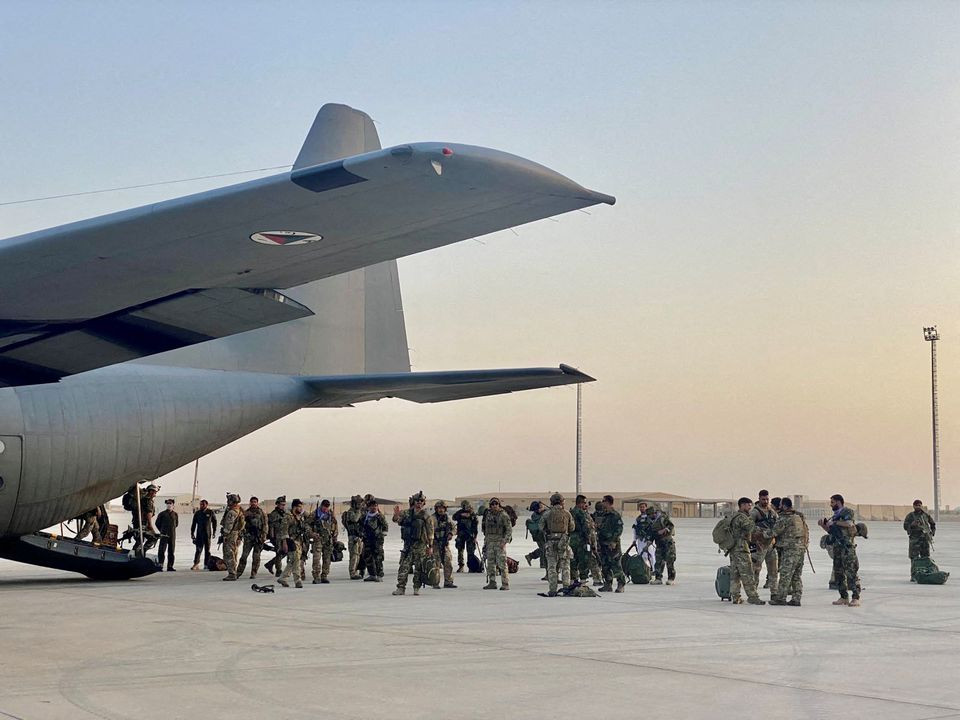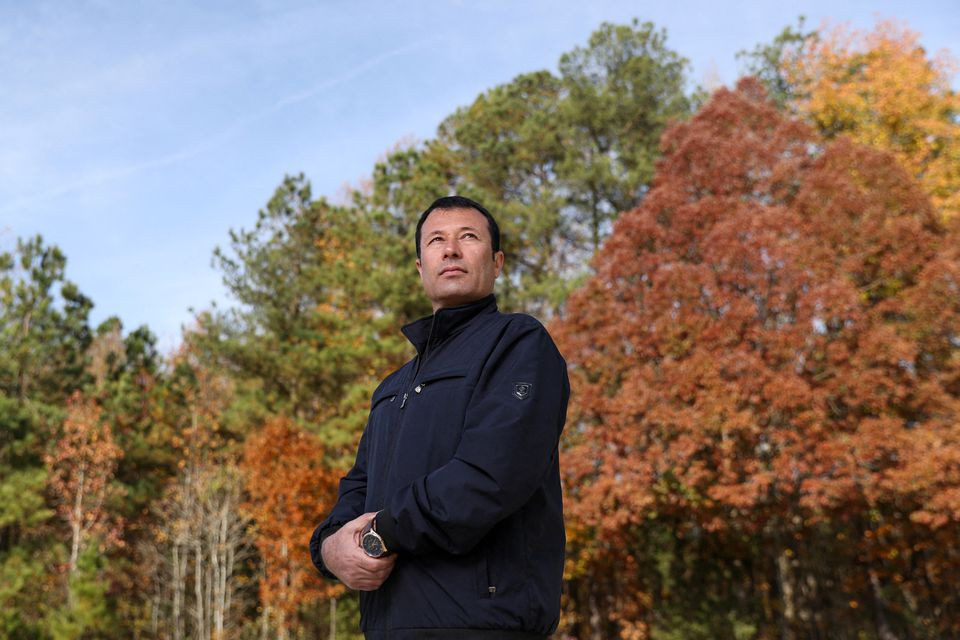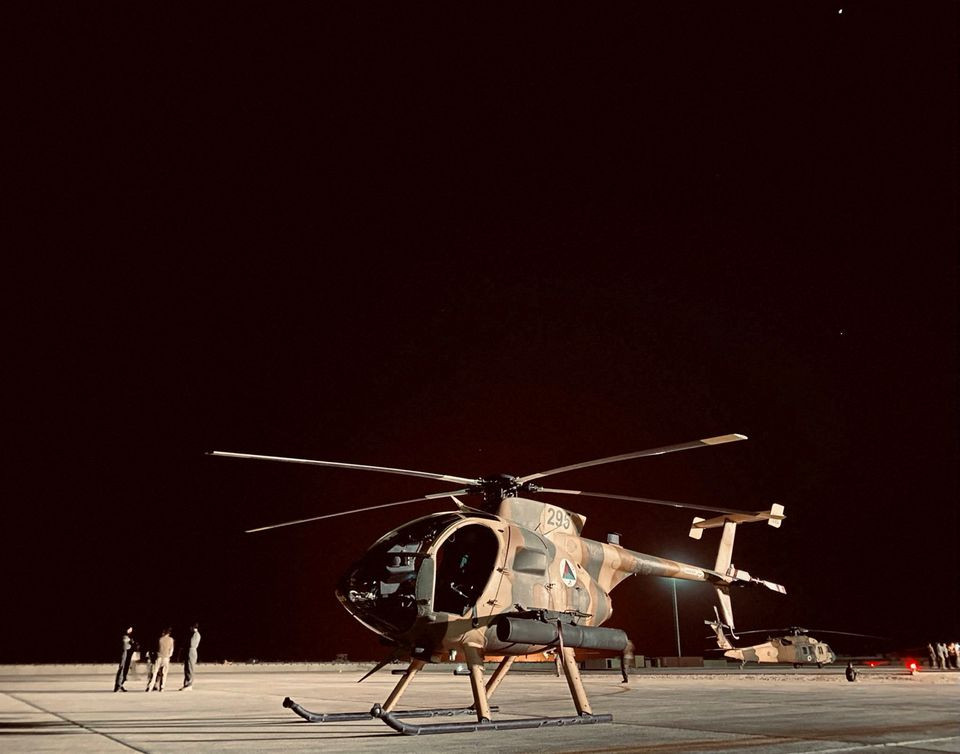Pilots detail how chaotic collapse of Afghan air force unfolded
Instead of unleashing air attacks against advancing insurgents, some airmen were fighting each other on Aug 15
WASHINGTON:Hours before Kabul fell to the Taliban on Aug 15, the Afghan Air Force was melting down. Instead of unleashing air attacks against advancing insurgents, some airmen were fighting each other.
At the Kabul airport, some Afghan Air Force personnel guarding the airfield tried to force their way onto a military helicopter preparing to lift off, according to the Afghan Air Force pilot flying the craft and two other people familiar with the incident. The chopper’s destination was across town, but the guardsmen were convinced it was leaving the country and were determined not to be left behind, the pilot told Reuters. Another guard, trying to stop them, pointed his gun at the cockpit.
Bedlam ensued. Shots rang out. Bullets pierced the helicopter. Debris and metal flew, injuring the pilot and another airman on board; both required treatment. “My face became full of blood,” the pilot said.
Afghan President Ashraf Ghani fled the country later that day, hastening the collapse of the US-backed government faster than even the most pessimistic defense analysts had predicted. Within hours, the Taliban stormed into Kabul, triggering a chaotic American evacuation that has damaged the presidency of US leader Joe Biden.
The melee involving Afghan Air Force members ahead of Kabul’s fall hasn’t been previously reported. Reuters also learned exclusive details from airmen and former Afghan officials who participated in the secret operation to fly Ghani and his entourage to neighboring Uzbekistan on Aug 15, and the role the chaos at the airport may have played in the timing of his departure. An Afghan Air Force C-130 at Camp Shorabak, Helmand province, Afghanistan, unloading Special Forces troops who are heading to battle against the1 Taliban August 3, 2021. PHOTO: REUTERS
An Afghan Air Force C-130 at Camp Shorabak, Helmand province, Afghanistan, unloading Special Forces troops who are heading to battle against the1 Taliban August 3, 2021. PHOTO: REUTERS
Those episodes are among the detailed accounts compiled by Reuters from more than two dozen people, including pilots, military personnel, government officials and other veterans of the conflict in Afghanistan and the United States. Their stories provide new insight into the final days of the Afghan Air Force, once the crown jewel of the nation's military.
The United States had spent billions building a flying force in Afghanistan to give Kabul an edge over Islamic insurgents. Bombing raids killed countless Taliban fighters, who had no air power of their own.
But that project unraveled in just weeks after the United States began withdrawing support in mid-2021 as part of its final pullout from the country.
Militants in sneakers and battered pickup trucks swiftly seized unprotected air bases as soldiers guarding those facilities gave up, often without a fight. Ammunition ran low. Aircraft fell into disrepair. Pilots pulled functioning planes and choppers back to Kabul to protect the capital, the last government stronghold.
But they would never execute that strategy. News of Ghani’s departure triggered a mass exodus of airmen trying to save their equipment - and themselves. Pilots, aircrews and even some of their relatives piled haphazardly into aircraft and fled the country. More than a quarter of the nation’s fleet ended up in neighboring Uzbekistan and Tajikistan, Afghan and US officials say.
"To be honest, we lost control" at the end, one former Afghan Air Force official said.
The fall was so swift that the Pentagon immediately dispatched US forces to Kabul to cripple dozens of US-supplied aircraft left behind to make them worthless to the Taliban.
John Michel, a retired brigadier general who once led the US training mission for the Afghan Air Force, expressed sadness, but not surprise, at the force's demoralised finale. He contends that the US template upon which it was modeled was not suited for a place like Afghanistan.
"It was an overly ambitious project that was, from the beginning, doomed," Michel said.
BUILT TO FAIL
The rapid disintegration was emblematic of the wider failures of the 20-year US involvement in Afghanistan.
Along with elite Special Forces units, the Afghan Air Force had been held up by the United States as proof that the drive to create a modern military to fight the Taliban was bearing fruit. The effort produced hundreds of courageous pilots who performed admirably under fire. But the force remained dependent on its American partners for core functions including aircraft maintenance and logistics. Impoverished Afghanistan, rife with corruption, lacked the military-industrial ecosystem and deep bench of talent needed for such an endeavor to stand on its own.
The Biden administration’s decision this year to withdraw from Afghanistan all US military personnel and contractors supporting the Afghan Air Force quickly exposed this weakness. Video chats with remote support staff could not replace on-the-ground help.
Asked about Reuters' findings about the crippling effects of ending hands-on assistance, the Pentagon said it had supported the Afghan Air Force even after the withdrawal, paying airmen's salaries, training pilots overseas, even conducting air strikes from overseas bases outside Afghanistan in support of Afghan air and ground forces into early August.
General Frank McKenzie, head of the US military's Central Command, warned Congress in April that he was concerned about "the ability of the Afghan Air Force to fly... after we remove the support for those aircraft."
It didn't take long. As the Taliban rolled through Afghanistan, grabbing province after province, the Afghan Air Force was asked to do more than ever to support the floundering ground war: bombing raids, medical rescues, troop transports. Its aircraft, meanwhile, were failing from overuse and lack of maintenance. The force lost one out of five usable aircraft between the end of June and the end of July alone, according to Pentagon data.
Ammunition too, was in short supply, Reuters has learned. An Afghan pilot, who asked to be identified only by his first name, Shah, recalled flying a dangerous medical evacuation mission in July to recover wounded and dead Afghan troops in Spin Boldak, near the border with Pakistan. Shah said he had two armed MD-530 attack helicopters to escort his UH-60 Black Hawk chopper. But one of the pilots warned they were low on ammunition and might not be able to help if Shah came under Taliban fire, the airman recalled.
Shah described a desperate scramble at the recovery site. "We were piling up bodies," he recalled. "There was even no time to check (for) their heart beat, due to high risk." Shah is still in Afghanistan, hiding from the Taliban.
A shortage of laser-guided bombs used for precise targeting of Taliban positions was also a guarded secret in Kabul in the final weeks of the war, said Hamdullah Mohib, who was Afghanistan's national security adviser.
"Our fear was that if we made this information public, it would further embolden the Taliban and demoralize ground troops," Mohib told Reuters.
The Pentagon, in a statement to Reuters, confirmed it halted a delivery of GBU-58 laser-guided bombs prior to the collapse of Afghanistan, but did not elaborate. A US defense official said Washington did not believe that decision harmed Afghan military operations.
Lords of the skies over Afghanistan, Afghan Air Force pilots such as Colonel Mohammad Tawiq Safi found themselves in peril as regional air bases below them fell to the Taliban. Colonel Safe Mohammad Tawfiq, who was the wing commander in the Afghan army in Mazar-e-Sharif, poses for a portrait in Fort Pickett, Virginia, US, November 20, 2021. PHOTO: REUTERS
Colonel Safe Mohammad Tawfiq, who was the wing commander in the Afghan army in Mazar-e-Sharif, poses for a portrait in Fort Pickett, Virginia, US, November 20, 2021. PHOTO: REUTERS
Safi was a wing commander in Mazar-e-Sharif, overseeing operations in north and northeast Afghanistan. He told Reuters he knew trouble was afoot on Aug 14 when local Afghan Army troops stopped answering his calls. Soldiers meant to protect the city - and his airfield - had abruptly folded. The 150 or so remaining airmen were on their own.
Safi gave the order to his airmen to retreat to Kabul, 200 miles away, where the Afghan Air Force had hoped to regroup for counter-attacks. By the time he got his own A-29 Super Tucano light attack plane aloft, he said, the fast-closing insurgents had struck his aircraft. Safi managed a landing, but was badly injured. Rescued by helicopter, Safi was ferried to Uzbekistan where he was hospitalized and ultimately evacuated to the United States in October.
The Taliban also hunted Afghan pilots on the ground. In the final months of the war, the Islamic militants devoted special attention to assassinating airmen when they stepped off base - a deliberate strategy to weaken the deteriorating air advantage of the US-backed government. At least seven pilots were killed off base this year in a series of targeted killings, Reuters reported in July.
More would follow. The last to die in this Taliban hit campaign may have been Hamidullah Habibi, a US-trained Black Hawk helicopter pilot. A week before the Taliban seized Kabul, Habibi was killed in the capital on Aug 7 by a sticky bomb attached to a vehicle, former officials and a family member said. The Taliban claimed responsibility.
The airmen also faced danger from their fellow countrymen as Afghanistan came unglued. Pilots controlled a precious means of escape, and some Afghans were willing to do anything to get on board their aircraft.
The Aug 15 scuffle between airmen at the Kabul airport was foreshadowed days earlier in Herat province in northwest Afghanistan.
The Taliban declared victory in Herat on Aug 12. Shortly before that, government officials and soldiers in the province wrangled over who could evacuate using the last available Afghan Air Force helicopters at Camp Zafar, home of the Afghan Army's 207th Corps, said a pilot and two former Afghan officials familiar with the incident.
Abdul Sabur Qane, Herat's provincial governor, and Ismail Khan, a powerful militia commander, demanded to be flown out with two other associates, the Afghan sources said. But the Afghan Army wouldn't let them. There were hundreds of soldiers at the base and only a couple of helicopters. The message: Either everyone leaves or no one does, the people said.
"The soldiers, they didn't allow them" to take the choppers, the pilot said.
Khan and his associates were later captured by the Taliban, then released. Khan and Qane could not be reached for comment.
WRECKING BALL
When the United States lost the war to the Taliban, it left behind a war chest of weaponry that will arm America's former enemies for years to come. Images from Afghanistan have shown insurgents toting M4 Carbine assault rifles, clad in American-made body armor and piloting US-supplied armored vehicles. Ensuring they didn't inherit an Air Force, too, became an urgent final mission for the United States.
Afghan pilots estimate they flew 46 aircraft to neighboring Uzbekistan and at least another 17 to Tajikistan, where they remain. The United States is weighing requests by those Central Asian countries to keep some of those aircraft, US officials told Reuters.
Then there was the handiwork of US Army Major Frank Kessler. A member of the Army's 82nd Airborne Division, Kessler flew into Afghanistan on Aug 17, two days after the fall of Kabul. His mission was to locate Afghan aircraft and other military equipment, then trash it to keep it out of Taliban hands.
In his first interview about his mission, Kessler told Reuters that his team of about 100 people located 73 military aircraft at the Kabul airport. Kessler's job was made harder by a restriction handed down from top brass: Don’t use explosives and keep a low profile.
The international spotlight was burning white hot on the Kabul airport in August. Washington had struck a fragile agreement with the conquering Taliban to allow the US military to conduct evacuation operations at the airfield through Aug 31. Blowing up planes at the airport could further panic the throngs of Afghans trying to board flights out. The sound might also tip off the Taliban that the Americans were destroying some of the most prized spoils of war. Subtler methods were needed.
"We couldn't take a thermite grenade or attach C-4 (explosives) to all the equipment there," Kessler said.
He declined to say exactly how the team disabled the aircraft, mostly UH-60 Black Hawk and Russian-made Mi-17 helicopters. But a US defense official, speaking on condition of anonymity, said the sabotage ran the gamut from low-rent vandalism such as clogging fuel lines with sand to the removal of sensitive, high-tech equipment. Images of the Kabul airport released by media organizations following the US evacuation showed choppers and planes with windows bashed in, avionics ripped out and doors missing.
"We had Air Force personnel there ... (who) understand how planes work and how to make them not work," Kessler said.
The new Taliban government has expressed aspirations of building its own Air Force. It has encouraged US-trained Afghan pilots to come out of hiding to help.
There have been few takers.
Six Afghan Air Force personnel still inside Afghanistan told Reuters they are terrified of their former adversaries and desperate to leave the country. Five of those in hiding described precautions like moving from house to house, deleting sensitive information from their cell phones and, in some cases, separating from family due to fears for their relatives' safety.
David Hicks, a retired US brigadier general who once commanded training for the Afghan Air Force, now leads a charity to evacuate and resettle former Afghan personnel. His group believes it has helped get hundreds of fliers and their family members out, but estimates far more still remain in Afghanistan.
"It's not an understatement to say that they're in a desperate situation," Hicks said.
FINAL FLIGHT
After the Aug 15 confrontation at the Kabul airport that injured two airmen, airfield security forces stopped yet another Afghan Air Force helicopter from taking off. This one was assigned to Ghani's presidential fleet. It eventually was cleared for departure, but only after one of the pilots aboard argued with the forces and Ghani's security got involved, according to several Afghans familiar with the incident.
The stand-off worried the president's inner circle. Concerns were rising about the ability of Ghani's own forces to protect him, Mohib, the national security adviser, told Reuters. While not the only factor, the incident contributed to the decision that it was time to get Ghani out of Afghanistan, Mohib said. An Afghan Air Force MD-530 at Camp Shorabak, Helmand province, Afghanistan, August 2, 2021. PHOTO: REUTERS
An Afghan Air Force MD-530 at Camp Shorabak, Helmand province, Afghanistan, August 2, 2021. PHOTO: REUTERS
"One of the reasons the decision was made that it was time to evacuate was because that helicopter was actually taken hostage," Mohib said. "The fear was that some (Afghan soldiers) had gone rogue."
The disorder continued as Ghani and his entourage began boarding three helicopters on the palace grounds to flee to Uzbekistan, one of the pilots told Reuters. After the president, his wife and some top-ranking officials, including Mohib, were aboard, some of Ghani’s bodyguards fought each other for the remaining seats, exchanging punches, a pilot told Reuters.
The three helicopters left the palace together just before 3 p.m., flying low to avoid radar as they headed north to keep the mission secret, the pilot said. A fourth helicopter followed in short order. One of the choppers was so crowded that the crew ordered body armor thrown overboard to lighten the load. The four aircraft carried a total of 54 people, half of them presidential security.
The pilots were told their destination just minutes before lift-off. They couldn't notify their families and left with nothing but their flight suits, two of the pilots told Reuters. Uzbek officials were surprised, too. The Afghans' unannounced landing at Termez airport triggered a scramble by Uzbek security, two Afghan pilots told Reuters.
The Uzbek foreign ministry declined to comment.
Arriving on Uzbek soil, Ghani mustered a last token of presidential gratitude for the crew.
"You saved all of our lives," the grim-faced president told them, one of the pilots told Reuters.
Ghani soon flew on to Abu Dhabi, capital of the United Arab Emirates (UAE), which announced he and his family had been admitted on “humanitarian grounds.”
Reuters was unable to reach Ghani through the UAE foreign ministry or via former members of his government.
Around 17 airmen - pilots, flight engineers and maintenance crew - had helmed Ghani’s mad dash to Uzbekistan. They boarded a charter flight to Abu Dhabi on Aug. 16 and eventually were moved into a humanitarian camp there. All are still awaiting US resettlement.
Saying they feel forgotten by the US government, and worried for their families back in Afghanistan, two of the pilots appealed for American help during interviews with Reuters.
"We did our duty," one said.
A US embassy spokesperson in Abu Dhabi declined to comment on the pilots' individual cases, but said in a statement that processing, screening and vetting of Afghans for relocation to the United States was a top priority.


COMMENTS
Comments are moderated and generally will be posted if they are on-topic and not abusive.
For more information, please see our Comments FAQ